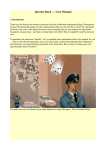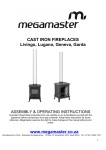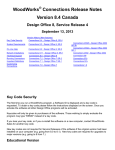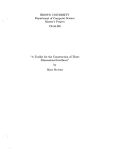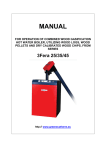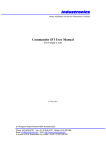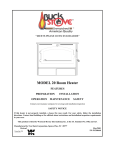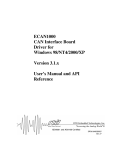Download User Manual for New Zealand
Transcript
ENVRIONMENTALLY FRIENDLY FIRE User Manual for New Zealand Authorisation number: 152619 (AS/NZS 4012/4013) Authorisation number: 154319 (ULEB) Website for authorised burners: http://ecan.govt.nz/services/online‐services/pages/authorised‐solid‐fuel‐burners.aspx EnviroSolve Ltd Exclusive Agent for New Zealand Dr Rene Haeberli Ohakune Road RD 3 Raetihi 1 Phone: 06 485 4871 Mobile: 021 24 24 211 Email: [email protected] Web: www.envirosolve.co.nz Contents 1. 5 Eco‐friendly advices for sensible heating ............................................................................. 4 2. Introduction ........................................................................................................................... 5 2.1 Warranty ....................................................................................................................................... 5 3. Bionic fire specification .......................................................................................................... 6 4. Installation instruction ........................................................................................................... 7 4.1 Warning: Health and Safety advice notice .................................................................................... 7 4.1.1 Handling ................................................................................................................................. 7 4.1.2 Fire Cement ............................................................................................................................ 7 4.1.3 Asbestos ................................................................................................................................. 7 4.1.4 Metal Parts ............................................................................................................................. 7 4.1.5 Important Warning – Preparatory Work and Safety Checks ................................................. 7 5. Installation ............................................................................................................................. 8 5.1 Installation distance in case of combustible walls ........................................................................ 8 5.1.1 Clearance Distance – Parallel Position ............................................................................ 9 5.1.2. Clearance Distance – Corner Position ............................................................................... 9 6. For the installer ..................................................................................................................... 10 6.1 Operating instructions ................................................................................................................ 10 6.1.1 Fuel ................................................................................................................................ 10 6.1.2 Drying and storage ........................................................................................................ 11 6.1.3 Room ventilation and stoves ............................................................................................... 11 6.2 Stove functioning ........................................................................................................................ 11 6.2.1 Automatic regulation for combustion air ............................................................................ 12 7. First Usage ............................................................................................................................ 13 8. Important Safety Advice ............................................................................................................ 14 8.1. Tips before firing up ................................................................................................................... 14 8.2 ‘Top‐down’ Lighting .................................................................................................................... 14 8.3 Warning! ..................................................................................................................................... 16 8.4 Cleaning and Care ....................................................................................................................... 17 8.4.1 Glass ..................................................................................................................................... 17 8.4.2 Paint finish ........................................................................................................................... 17 8.4.3 Mechanical cleaning ............................................................................................................ 17 8.4.4. Prolonged period of non‐use .............................................................................................. 17 8.4.5 Cleaning the combustion chamber. ..................................................................................... 18 8.4.6 Cleaning of flue ways ........................................................................................................... 19 2 9. Interruption of operation ...................................................................................................... 21 9.1. Smoke spillage around the door ................................................................................................ 21 9.2 Soot on glass ............................................................................................................................... 21 9.3 Stove is burning too strong ......................................................................................................... 21 9.4 Stove is burning too weakly ........................................................................................................ 21 10. Secure the fire ......................................................................................................................... 22 Appendix ...................................................................................................................................... 23 1. Drawings for the spare part ...................................................................................................... 23 2. Legend for the spare parts ........................................................................................................ 24 3. Technical drawing of the bionic fire .......................................................................................... 25 3 1. 5Eco‐friendlyadvicesforsensibleheating Effective lighting: use dry brushwood, kindling and possible a piece of newspaper or a fire lighter Light the fire with only little wood at the time – this give the best combustion Lean the door to catch for 5 – 10 minutes until a nice fire has established Shut the door properly afterwards Use only dry wood ‐ i.e. wood with a humidity of 15 – 22 % The oven is wrapped in packaging that is recyclable. This must be disposed accordingly to national rule regarding the disposal of waste. The glass cannot be reused. The glass should be discarded along with the residual waste from ceramics and porcelain. Pyrex glass has a higher melting temperature and therefore cannot be reused. If discarded you make an important positive contribution to the environment. 4 2. Introduction Thank you for purchasing a RAIS wood burning stove. A RAIS wood burning stove is more than just a heat source. It also shows that you care about design and quality in your home. To make the most of your wood burning stove it is important that you read the manual thoroughly before installing and using it. In the case of warranty coverage and for general queries regarding your wood burning stove, it is important that you know the stove’s production number. We, therefore, recommend that you note down the number in the table below. The production number is located on the back of the stove at the bottom. 2.1Warranty Your Rais wood burning stove come with a 5 year warranty. The warranty, however, does not cover heat‐insulating materials, glass and seals. The appliance must be serviced and maintained using parts approved by the manufacturer, to achieve the proper performance of the appliance. Any alterations made to the stove will void the warranty. The name is a registered trademark. Date: ………………………………… Distributor: EnviroSolve Ltd Ohakune Road email: [email protected] RD 3 phone: +64 (0) 6 385 4871 Wanganui mobile: +64 (0) 21 24 24 211 New Zealand www.envirosolve.co.nz 5 3. Bionicfirespecification Nominal Output (kW) Min. / Max. Output (kW) 4.6 3.9 – 4.6 Heating area (m2) 45 ‐ 83 Stove's width/depth/height (mm) without socket 472‐482‐1064 Combustion chamber's width/depth/height (mm) Upper combustion chamber 280‐200‐300 Recommended amount of when fuelling (kg) Distributed p 1 ‐2 logs of wood approx. 25 cm Weight socket included (kg) approx. 180 kg Refuelling should be undertaken within 1 1/2 hours Intermittent operation 6 1.1 4. Installationinstruction The following pages give instructions for the safe and proper installation of this heating appliance in New Zealand. These instructions cover the basic principles of installation, although detail may need slight modification to suit particular local site conditions. In all cases the installation must comply with the current New Zealand Building Regulations, local authority byelaws and other specifications or regulations as they affect the installation of the stove. Please not that it is a legal requirement under New Zealand Building Regulations that the installation of the stove is either carried out under Local Authority building control approval or is installed by a competent person registered with a government approved competent person scheme. 4.1Warning:HealthandSafetyadvicenotice Ensure the heater is installed in accordance with all current local building and safety regulations. Attention is drawn in particular to the following. 4.1.1Handling The appliance is a heavy item and adequate facilities must be available for loading, unloading and site handling. 4.1.2FireCement Some types of fire cement are caustic and should not be allowed to come into contact with the skin. Protective gloves should be worn when handling fire cement. In case of contact with skin the skin should be washed immediately with plenty of water. 4.1.3Asbestos This stove contains no asbestos. I there is a possibility of disturbing any asbestos in the course of installation then please seek specialist guidance and use appropriate protective equipment. 4.1.4MetalParts When installing or servicing this stove care should be taken to avoid the possibility of personal injury. 4.1.5ImportantWarning–PreparatoryWorkandSafetyChecks This stove must not be installed into a chimney that serves any other heating appliance. It is recommended not to have an extractor fan fitted in the same room as the stove as this can cause the stove to emit fumes into the room. 7 5. Installation The is a free standing stove and has a steel socket. The stove must be set up and installed in accordance with all current national and local rules and regulations. Local authorities and a chimney specialist should be contacted prior to set up. It is prohibited to carry out unauthorized alterations to the stove. There must be plenty of fresh air in the room where the stove is being installed, in order to ensure proper combustion. Note that any mechanical exhaust ventilation ‐ i.e. an extraction hood ‐ may reduce the air supply. Any air grates must be place in such a manner, that the air supply is not blocked. The floor structure must be able to carry the weight of the wood burning stove as well as the weight of the chimney, if necessary. The fire is placed on fire proof material. When you choose where to set up your RAIS wood burning stove, you should consider the heat distribution to the other rooms. This will enable you to get the best use out of your stove. The stove should be set up at a safe distance from inflammable material. Upon receiving the stove must be inspected for defects! 5.1Installationdistanceincaseofcombustiblewalls To determine whether the wall next to where the stove is going to be installed is flammable, you should contact your building contractor or the local building authorities. The hearth should be able to accommodate the weight for the stove. The weight of the stove is indicated in the brochure. If the stove is to be installed on a wooden floor, it must be covered with a non‐combustible material at least 12 mm thick in accordance with New Zealand Building Code. The clearance distance to combustible material beneath surrounding or upon the hearth and wall adjacent to the hearth should comply with the guidance of the New Zealand Standard AS/NZS 2918‐2001 Appendix B. 8 5.1.1 ClearanceDistance–ParallelPosition Parallel Position Clearance Distance A E B D D C Clearance Position (mm) (A) Rear 100 (B) Side 250 (C) Floor protector (front) 300 (D) Floor protector (side) 200 (E) Flue (rear) 5.1.2.ClearanceDistance–CornerPosition Corner Position Clearance Distance J Position Clearance (mm) (F) Side 120 (G) Side 120 (H) Floor protector (front) 300 (I) Floor protector (side) 200 F I G H I (J) Flue (rear) * Note that this temperature passed within the laboratories margin of uncertainty. Technical Note: !No flue shield is required! 1. The clearance measurement A, B, F and J were taken from the distance between walls and closest point of the appliance, C and H was measured from the front of the fuel-loading opening to the edge of the floor protector, D and I was measured from each side of fuelloading opening, E and J were calculated from the flue’s centre to the rear wall. 2. The flue was installed onto the flue spigot, extended centrally and vertically without bend before and after penetration of the ceiling plane. 3. Drawings shown above are not to scale. 9 6. Fortheinstaller Finally, before firing the stove the first time a check should be made to ensure that the assembly and stove installation has been satisfactory and that there are no leaks in any seals in the appliance and appliance connections to the chimney. Ensure that the appliance and the chimney flue are functioning correctly before finally handing over to the user. If necessary read the later parts of this manual for guidance on care required when first lighting. Inform the user that the appliance has been commissioned and ready to use and give instruction on the safe operation of the stove. These instructions must be left with the user and the user should be instructed to keep them in a safe place. 6.1Operatinginstructions Please note that the appliance approval only covers the use of dry seasoned wood logs on this appliance. This approval does not cover the use of other fuels either alone or mixed with the wood logs nor does it cover instructions for the use of other fuels. 6.1.1 Fuel The stove is designed and approved in accordance with AS/NZS 4012/4013 and AS/NZS 2918‐2001 Appendix B for stocking dried firewood. The firewood must have a water content of 15 – 22 % and it maximum length should be the width of the combustion chamber minus 50 – 60 mm. Stocking with wet firewood causes both soot and environmental pollution and is bad fuel economy. Freshly cut wood contains approx. 50 – 70 % water and is thoroughly unsuitable for stocking. Count min. 1 year of storage time for newly cut wood before using. Wood with a diameter of no more than 100 mm should be split. Regardless of wood size, it should always have at least one surface area free of bark. The following fuels are prohibited and must not be used: Painted, laminated or treated (impregnated) wood, wood with a synthetic surface, painted refuse wood, chipboard, plywood, domestic waste, paper briquettes and pit coal, as this will produce malodorous smoke, which could be poisonous. The use of such fuels may damage the appliance and will void the warranty. When firing with the above mentioned items and the amounts larger than those recommended, the stove is subjected to a larger amount of heat, which results in a higher chimney temperature and lower efficiency. This can result in the stove and chimney becoming damaged and would void the warranty. 10 The calorific value of the fire wood is closely connected to the moisture level of the firewood. Moist firewood has a low heat value. The more water the wood contains the more energy it takes this water to vaporize resulting in energy is being lost. 6.1.2 Dryingandstorage Drying wood takes time. Proper air drying takes approx. 2 years. Here some tips: Store the wood sawn, split and stacked in an airy, sunny place, which is protected against rain. Store firewood stacks at a hand’s breadth apart as this ensures that the air flowing through takes the moisture with it. It is a good idea to bring the firewood into the house 2 – 3 days before you need it. 6.1.3Roomventilationandstoves If there is an extractor fan in the same room as the bionic fire please make sure that the bionic fire is not closer than 2 meter to the extractor fan. The stove requires a permanent and adequate air supply in order for it to operate safely and efficiently. In accordance with the current building regulation the installer may have fitted a permanent air supply vent into the room in which the stove is installed to provide combustion air. This air vents should not under any circumstance be shut off or sealed. 6.2Stovefunctioning The stove has 2 combustion chambers: The upper combustion chamber (UCC) is for kindling and re‐fuelling The lower combustion chamber (LCC) is for the post‐combustion and must not be used for kindling and re‐fuelling. Dome Upper Combustion Chamber (UCC) Lower Combustion 11 Chamber (LCC) A post‐combustion provides a good usage of fuel energy and an almost complete combustion of the toxic and harmful substances from the smoke. Upon lighting the air flows through the UCC and to the flue pipe (chimney). When the stove reaches a certain temperature the air flow is diverted and the still unburned gasses are lead from the UCC through an opening in the bottom stone plate to the LCC. Over the opening is a steel dome placed. Flames are thus lead through the opening to the LCC for post‐combustion of the gases. 6.2.1Automaticregulationforcombustionair The stove is equipped with an independent and self‐regulating air damper. Hence there is no damper handle. The primary air is added to the primary combustion zone, i.e. the bed of glowing embers. The cold air is only used in the lighting stage. Secondary air is added in the gas combustion zone, i.e. air which contributes to the combustion of the pyrolysis gases (preheated air, which is used for the cleaner glass system and the combustion). This is air sucked through the damper and is pre‐heated through the side channels and then emitted as hot scavenging air onto the glass. The hot air rinses the glass and keeps it soot free. A clean combustion is indicated by clear yellow flames. The pilot nozzles are placed in the back plate of the upper combustion chamber. They ensure that the bed of glowing embers is fed with air and therefore holds a high temperature. It provides a quick start when re‐fuelling and reduces the risk of fire going out. Important! ‐ during kindling / refuelling If an ash pan is use, it must be placed at the bottom on lower combustion chamber. 12 7. FirstUsage Important: Place wood only in the upper combustion chamber. This applies for kindling and re‐fuelling. A careful start pays off. Start with a small fire, so that the wood burning stove can get accustomed to the high temperature. This gives the best start and any damage is avoided. Be aware that a strange but harmless odour and smoke concoction may emanate from the surface of the stove, the first time you fire up. This is because the paint and materials need to harden. The odour disappears quickly, but you should check the ventilation and draught, if possible. See also the important warning notice below about persistent fumes. During this process you must be careful not to touch the painted surfaces. It is recommended that you regularly open and close the door to prevent the door seal from sticking. The stove may also produces ‘clicking noises’ during heating and cooling caused by the large temperature differences witch the material is subjected to. Never use any type of liquid fuel for kindling or maintaining the fire. There is a danger of explosion. The stove gets very hot when in use. Always wear protective gloves when tending the stove. If the stove has not been used for a while, follow the steps as if you were using it for the first time Important Warning Note! Properly installed, operated and maintained, this appliance will not emit fumes into the dwelling. Occasional fumes from de‐ashing and re‐fuelling may occur. However, persistent fume emission is potentially dangerous and must not be tolerated. If fume emission does persist the following immediate actions should be taken: Open doors and windows to ventilate the room. Let the fire out or eject and safely dispose of fuel from the appliance. Check for flue or chimney blockage and clean if required. Do not attempt to relight the fire until the cause of the fume emission has been identified and corrected. If necessary seek expert advice. Important Warning Note! Do not use an aerosol spray on or near the stove when it is alight! 13 8.ImportantSafetyAdvice When using the stove in situations where children, aged and/or infirm persons are present a fireguard must be used to prevent accidental contact with the stove. The fireguard should be manufactured in accordance with all current local building and safety regulation. Lighting and fuelling Note: If the air system is connected the valve must be open. Loading the stove with larger amounts of wood fuel than is recommended in Section 8 of these instructions may generate excessive heat. This may also damage the appliance and void the warranty 8.1.Tipsbeforefiringup Open a door or window close to the wood burning. It here is a ‘storm’ in the stove coming from the chimney, it is advisable to place a screwed‐up piece of newspaper between the upper baffle plate and the chimney, set the paper on fire and wait until you hear a ‘rumbling’ noise in the chimney. This means there is definitely a draught in the chimney and avoid smoke in the room. 8.2‘Top‐down’Lighting Open the door an lock it using the small bracket at the bottom of the door. Start by placing 1 piece of split log – approx. 1 kg – at the bottom of the upper combustion chamber (UCC) in front of the dome to the small front glass. Place approx. 1.2 kg of dry firewood, split in to kindling sticks behind the log and a couple of alcohol briquettes (fire lighter) or similar. Light the fire and close the upper convection plate of the stove. 14 Close the door and leave it ajar by tipping the handle. When the fire has caught the kindling close the door completely (approx. 5 – 10 minutes). When the temperature reaches a certain value the damper will divert the smoke. This causes a downward flame form the upper (UCC) to the lower chamber (LCC). When the last flames are extinguished and there is a nice layer of embers add 1 – 2 pieces wood (about 1 ½ kg). Place the wood on top of the dome at the rear of the UCC. Close the door completely. Note! If the fire has burned down too low (too small ember) it may take longer for the flames to be diverted to the LCC and thus achieve a cleaner burns. When firing the smoke out of the chimney should be almost invisible – just a ‘flicker’ in the air is observed. When re‐fuelling, open the door carefully to avoid smokes escaping. Never add wood while it is burning (flames!) in the stove. RAIS recommend re‐fuelling with 1 – 2 pieces wood (approx. 1 – 1 ½ kg) within 1 ½ hours (intermittence operation). Attention! Keep an eye on the stove when lighting. During the operation the door should always remain shut. Control Look for signs that indicated a correct firing in the stove: Ash is white The walls of the combustion chamber are free of soot The wood is sufficiently dry 15 8.3Warning! If the firewood is only burning slowly without flames or is smoking and too little air is added, unburned exhaust gases are developed. Exhaust gases can be ignited and explode, leading to damage the material and possible injure personal. If there are only a few embers remaining you must light the fire again. If you just add firewood the fire will not be lit, but unburned exhaust gases will develop. Here firewood has been added to an ember layer which is too small. The air flow is too small – smoke has been developed. Avoid heavy smoke – danger of exhaust gas explosion. In case of very heavy smoke open the door and light the fire again. 16 8.4CleaningandCare 8.4.1Glass Most of the wood stoves use a ceramic glass product which is resistant to heat but requires cleaning to keep its appearance. Soot or opaque marks can be easily cleaned if the marks are fresh. However, if the glass left dirty for any length of time the acid from the wood can etch the surface of the glass permanently (wet unseasoned wood, soft wood such as used in the building industry and pallet wood should be avoided. Only clean when cold. Use only stove glass cleaners to remove heavy tar / soot deposits. All other marks can normally be removed with a damp cloth, then dry with a clean cloth or newspaper. Do not let the glass dry before applying a dry clean cloth. With more stubborn marks i.e. opaque areas/frosting, you need to put a small amount of wood ash on a clean damp cloth. If the opaque mark/frosting doesn’t come out, contact you dealer for a special remover. 8.4.2Paintfinish The appliance has been coated with a high temperature paint which can last for years. Do not clean with a damp cloth or any cleaning products as they can cause rust or discoloration. Only clean when cold, use a brush with soft bristles or dust with a lint free cloth. Only re‐ spray when necessary. 8.4.3Mechanicalcleaning The wood burning stove and the chimney must be service by a chimney sweep at least once a year. During cleaning and care, the stove must be cold. 8.4.4.Prolongedperiodofnon‐use If the stove is to be left unused for a prolonged period of time then it should be given a thorough lean to remove ash and unburned fuel residues. To enable a good flow of air through the appliance to reduce condensation and subsequent damage leave the air controls fully open. Prior to a new hating season it should be checked that eh chimney and smoke gas connector are not blocked. 17 8.4.5Cleaningthecombustionchamber. Scrape or shovel the ash out and store it in a non‐flammable container until it has cooled down. You can dispose the ash with your normal household waste. REMEMBER! Never remove all the ashes from the combustion chamber – the wood will burn at its best with a layer of ashes of approx. 20 mm. Remove gently the steel dome and the small front glass (ash stop). Front glass (ash stop) Dome Regarding the cleaning of the upper combustion chamber the ash pan can be used. The pan is placed underneath the UCC in 2 brackets. Ash pan Bracket The ashes are swept on to the ash pan and disposed of. Replace the ash pan in its position in the lower combustion chamber again. The ash pan must not remain under the upper combustion chamber: The door cannot be closed and can be damaged. 18 The ash pan will damage the special function of the stove (afterburning in the lower combustion chamber). 8.4.6Cleaningofflueways 8.4.6.1Uppercombustionchamber(UCC) In order to access the flue ways gently remove the smoke converter plate (vermiculite) by tilting I t to one side and turning it a little slantwise. Pull out the plate carefully. Remove dirt and dust and the parts in reverse order. Note! Be careful when replacing the smoke converter plate. 8.4.6.2Lowercombustionchamber(LCC) 1. One bracket for the ash pan underneath the UCC is removed (use Allen key 4 mm) 19 2. The bottom plate is gently lifted out of its position with a wide slotted screwdriver 3. The side plate is gently removed. 4. The back plate is gently removed. 5. Remove dirt and dust and mount the parts in reverse order. Note! Be careful when replacing the plates. 20 The appliance must be serviced and maintained using parts approved by the manufacturer, to achieve the proper performance of the appliance. 9. Interruptionofoperation 9.1.Smokespillagearoundthedoor It could be due too low draught in the chimney < 12 Pa. Check whether the flue or chimney is blocked Check whether the extraction hood is switched on. If it is, switch it off and open a window or door in the proximity of the stove for a short while. 9.2Sootonglass It could be caused by too wet firewood. Make sure that the stove is heated properly when firing up, prior to closing the door. 9.3Stoveisburningtoostrong It could be caused by: Leak around the door seal Chimney draught is too large > 22 Pa; draught regulator should be installed 9.4Stoveisburningtooweakly It could be caused by: Too small amount of firewood Too little air supply for room ventilation Unclean smoke channels Leaky chimney Leakage between chimney and flue If the stove continues to malfunction, we recommend that you contact your RAIS distributor or you chimney sweep. Warning! In case of a chimney fire: Shut off all air supply from outside (if installed) to the stove Contact the fire department Never attempt to put out the fire with water! Afterwards, you should ask your chimney sweep to check the stove and chimney 21 Important! To ensure safe burning there must be clear yellow flames or clear embers at all times. The firewood should not be smouldering. 10.Securethefire Due the following regulation AS/NZS 2918 the fire must be bolted secure to the floor to comply with the New Zealand Standard. See below 3.8. 3.5 Stability An appliance shall be installed with sufficient stability so as not to detract from the intended normal operation of the appliance nor to create a hazard for users of the appliance. 3.8 Seismic restraint Where required by the regulatory authority, provision shall be made for seismic restraint of the floor protector and the appliance. Sufficient restraint shall be provided to resist a seismic loading equal to 0.4 times the mass of the appliance. The load shall be applied horizontally in any direction at the mid‐height of the combustion chamber. The appliance shall not move, tilt or be dislodged from its installed position during application of the load. Notes: 1. The seismic loading is to be applied before the flue system is installed 2. Where the appliance is secured to the floor protector the test is to be applied to the combination at a point approximately 100 mm above the top surface of the floor protector. 22 Remove the adjustable feed from the stove. Use the M8 threads to bolt the fire to the floor. Appendix 1. Drawingsforthesparepart 23 2. Legendforthespareparts 24 3. Technicaldrawingofthebionicfire 25




























